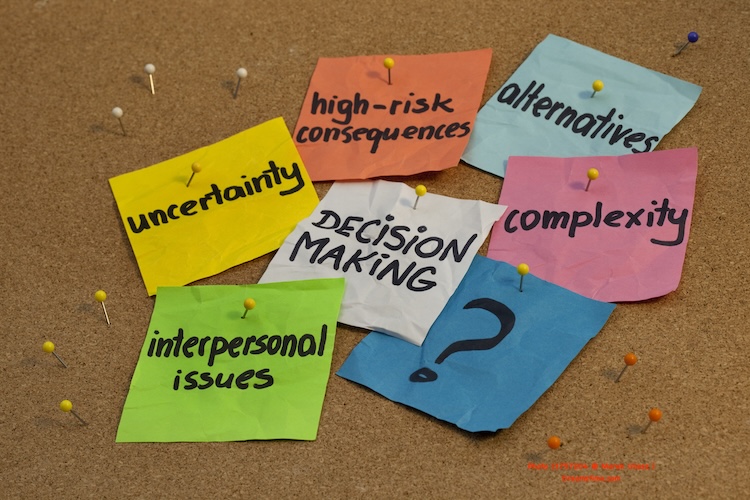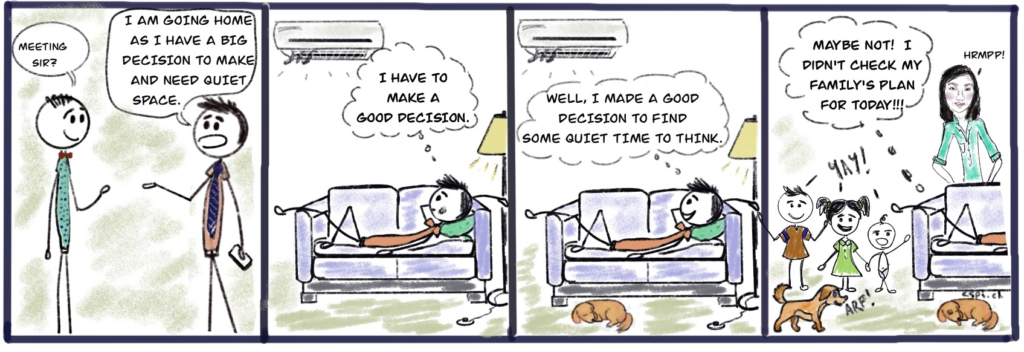In this article we will look at our thinking when considering a decision.
We have wonderful and sometimes scary conversations with ourselves. when considering a decision.
Usually, the ‘scary conversation’ starts with ‘what if. ….?’ followed by scenarios of what could go wrong. They can keep us stuck and unable to make a decision.
‘Wonderful conversations’, on the other hand are thoughts, imagining what will go right if you make a particular decision.
As managers, the scary conversations are driven by avoiding risk. The risk is all we can see. Wonderful conversations, on the other hand, can paint over risks with optimistic scenarios. imagine a decision to make a bigger bet at a casino to make up for what you have lost!
We want to avoid the downsides of scary and wonderful conversations.
What works is to guide our thinking by posing a series of questions.
Questions are very powerful in focussing the mind. They keep us away from the extremes of over-optimism and overwhelming risks.
Question also have this quality of demanding an answer.
You’ve likely experienced someone asking you a bit personal question . In spite of this, very often, we answer the question. We have a built-in need to answer any question that we are asked. Pushy sales people often use questions as a method of manipulating a conversation to make you believe that you need to buy what they are selling. Sadly, it often works.
But we use questions in decision making in a good way.
The first question is:
Do I need to make the decision. Is this my decision to make? And, if so, what is the decision I need to make?
The decision might be demanding a yes/no or go/no go answer to a proposal or request.
It might be more complicated with a wealth of possible solutions.
Define the decision needed using the desired outcomes, which brings us to question two.
The second question is:
What are the desired outcomes of this decision?
The outcomes can be varied, but typically involve…
– Direction taken
– Costs incurred
– The reactions of others
– The numerical results of the decision (sales, costs, trend increase, number of customers, competitive advantage)
– Managed downside risk
– Aligned with values and strategy and policies
– Time, quality and value.
Example: The decision needed is to set the price for a service X that will grow our profits while, also, maintaining our market share.
The Third Question is:
What information do I need to make this decision?
Sub-decisions you make at this time are: how are you going to obtain the information?, who you are going to request to provide information? and in what format do you need the information?
Information can come from available data, discussions with others, formal surveys, brain storming sessions.
The fourth question is:
What criteria will I use in making the decision?
Naturally, the criteria will depend on the nature of the decision being made. However, commonly, the criteria fall into four brackets.
The first is the hard outcomes required
The second will relate to people in the company. Do they need to be fully on board to ensure successful implementation of the decision? Do they need to be happy?
The third is alignment with vision, values and policies of the company.
The final one is about risk. Risk is the possible outcome if the implemented decision doesn’t meet it’s hard or people outcomes. People look at risk based on where they fit on a conservative to high risk continuum. One person’s risk is another’s comfort zone. Know your own level of risk avoidance. or acceptance.
First consider the worst case scenario. Then ask the question: ‘Will we survive that scenario?’ If the answer suggests that the worst case scenario can be a setback, but does not threaten the whole company it might be acceptable, or not, if the setback is large. On the other hand, if the worst case scenario is really bad and is a possibility, then managing the risk will be a major consideration in your decision-making.
You want to avoid being drawn in by the excitement of the results that could follow from your decision. As a manager you want to take a hard look at what might go wrong. Period. To do this invite others to help you develop an understanding of what might go wrong.
A list of things that might go wrong enables you to think about how your decision can be made and implemented in a way that manages to avoid the possibilities on the list.
A very dangerous situation is for a manager to be totally committed to a particular decision without considering the downsides, or the difficulty or acceptance of implementing the decision. Very often sales and marketing managers are guilty of falling in love with their plans for sales or market growth, and do not take the time to carefully consider the consequences should something go wrong.

The Fifth Question
“What options do I have? What are my decision choices?”
Your option might be ‘yes’ or ‘no’ or Mary or John? In this case choices are clear and you go to question 6.
Often the decision is not binary. Competing strategies, pricing or policies are not that simple. Organizational decisions can be complex. Even people issues can have multiple choices: ‘ Do I write this person up?’, ‘Do I focus on coaching the person?’, ‘Do I demote the person?’ Do I give him/her a different role?’
Before moving to decide you need to know what choices to consider. These can then be used as a starting point for comparing them.
The Sixth Question
‘What is my decision and how do I explain it?’
When you have defined the purpose for the decision, obtained the information that is adequate for you to make the decision, looked at the impact on people, and considered the possible downsides and options you are ready to answer the sixth question.
To make the decision you look at the answers to all the questions and apply them to your possible choices. Try to eliminate some choices early. This will leave you with possible decisions that you can then do a deep comparison on. The comparison covers three main areas also posed as questions.
Question one: ‘Do all the possible decisions achieve the objectives?
Question two: ‘What is the level of risk for each decision?’
The answers include the likelihood of unwanted outcomes occurring.
In answering this question, know your own risk tolerance. If you are very risk intolerant then you would be wise to discuss the risk with others who are less risk averse but not high risk takers. On the other hand, if you’re a high-risk taker, you would be wise to discuss the risks with others who are more risk averse.
Question three: ‘Which option am I going to choose?’ This is when you MAKE the decision!
Having made your decision the next step is communicating it or, in some cases, getting approval for it. To do this, you’re taking into consideration your audiences. How will they accept your decision?
You will need a story that explains your decision, what outcomes you expect from it and what actions need to be taken to implement it and what risks you have considered and need to be managed.
Do not be surprised if some disagree with the decision you made.
Remember that you have made a good decision . You have considered as many aspects of your decision of which you are aware and you have used information and consultations with others as needed.
Therefore, you need to stand by your decision and be willing to argue for it if necessary.

